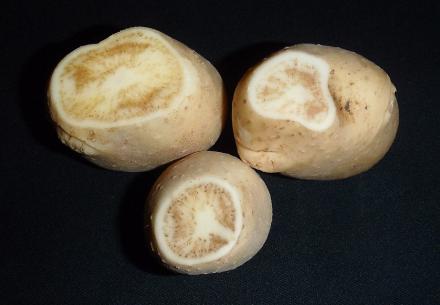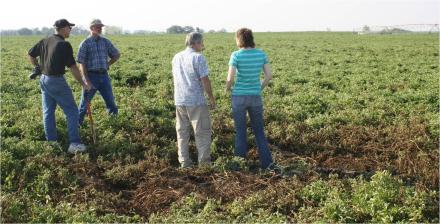USA
September 17, 2024
Zebra chip is a disease of potatoes that has no cure, but scientists are on the case. They know the bacterium that causes the disease and the insect that carries it. But now, researchers have discovered something they did not know – three new genetic variants (known as haplotypes) of the bacterium and four new insect carriers.
The bacterium is known as Candidatus Liberibacter solanacearum (Lso). Scientists previously knew of three Lso haplotypes in U.S. potato crops but were uncertain whether all three variants are vectored (transmitted) only by the same insect, the potato psyllid. This uncertainty led scientists to collect psyllids other than potato psyllid to look for presence of Lso. The searchers led to the unexpected discovery that there are four psyllids other than potato psyllid that harbor Lso in Washington and Oregon. More interestingly, the Lso harbored by these four psyllids are new variants previously unknown to science. Scientists now are evaluating the psyllid hosts to determine if they transmit these new Lso variants to potato.

Tubers infected with zebra chip disease show dark, stripelike symptoms in the tissue. The damage becomes even more pronounced when the potatoes are made into chips or fries. (Photo by Joseph Munyaneza)
“The finding of new Lso haplotypes in non-potato psyllid species suggests that our understanding of the Liberibacter pathogen biology, including its vector and plant host range, is limited,” said Kylie Swisher Grimm, a plant pathologist at the ARS Temperate Tree Fruit and Vegetable Research (TTFVR) unit in Wapato, WA. “One of the new haplotypes we identified was found in three psyllid species belonging to two different psyllid families (Aphalaridae and Triozidae). This means that despite having different host plants, these psyllids fed on a common plant species and were all able to acquire the pathogen.”
Psyllids transfer the Lso to potato plants when they feed by sucking sap. Infected plants eventually die, but even if the tubers are harvested, they are unmarketable. While not harmful to people, zebra chip leaves unsightly striping inside the tuber and makes it taste bad.
Swisher Grimm noted that scientists are now facing several questions: Can the newly identified psyllids transmit the new Lso haplotypes to potatoes? Can the potato psyllid acquire these new Lso haplotypes by feeding on a common plant species with the Aphalaridae or Triozidae psyllids? Can these haplotypes cause the same yield and quality losses as the haplotypes currently associated with zebra chip disease of potato?
“If the answer to any of these questions is yes, growers may need to alter their integrated pest management programs to avoid potential losses,” Swisher Grimm said.

Researchers, including Kylie Swisher Grimm, right, study a field that had been attacked by the Lso bacterium. (Photo by Fekede Workneh)
According to David Horton, an entomologist with TTFVR, potato psyllids can also transmit the zebra chip pathogen to crop relatives of potatoes, such as tomatoes and peppers, often with damaging results. The bacterium is also related to the organism that causes greening in citrus.
Zebra chip was first detected in 1994 in potato fields located in northern Mexico, and then for the first time in the U.S. in Texas in 2000. The disease has made its way through North America, Central America, northern South America, Australia, and New Zealand.
“A recent review pegged economic losses to zebra chip disease in the U.S. and Mexico during the initial phases of the disease (mid-2000s) in the tens of millions of dollars,” Horton said. “Insecticide costs to control potato psyllid exceeded $700 per hectare (nearly 2.5 acres) in some outbreak regions.”
Horton said that more research on psyllids is required because there are no “rescue” treatments for crop plants that have become infected by Lso.
“Once Lso is present in the plant, the disease-causing bacterium cannot be destroyed except by killing the plant. This means that controlling Lso in crops requires controlling the psyllid host, typically by insecticides. To optimize these controls, we need a better understanding of psyllid biology.”
That research is underway.
“We targeted specific genes within the Lso pathogen and psyllids themselves to generate sequence data that could help us better identify and characterize our specimens,” Swisher Grimm explained. “Sequences that are more closely related often indicate that similarities exist in host plant preferences or vector species. This information provides a good starting point for researchers working to understand the range of a new pathogen haplotype or insect vector.” – by Scott Elliott, ARS Office of Communications
Visit Spud Central to learn more about ARS potato research.